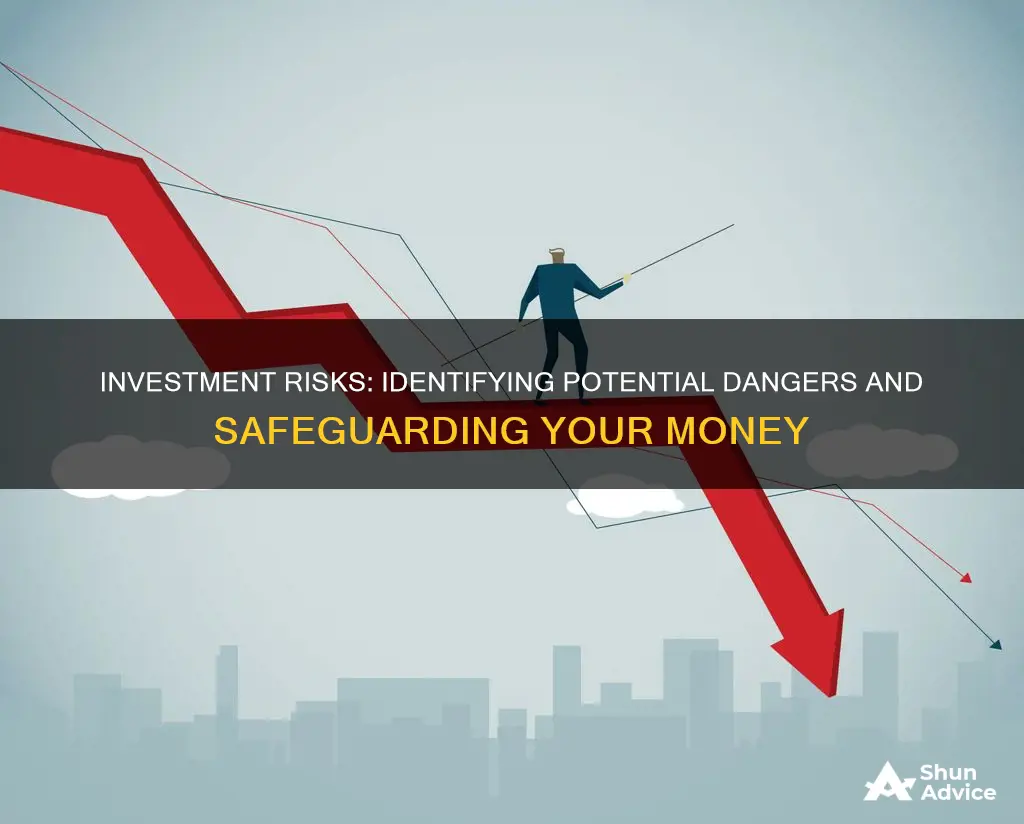
All investments carry some degree of risk, and it's important to be aware of how your money could be affected. Risk is defined in financial terms as the chance that an investment's actual gains will differ from the expected outcome or return. This includes the possibility of losing some or all of the original investment. In this article, we will explore the different types of investment risks, how to calculate them, and how they can impact your financial goals. We will also discuss ways to manage and mitigate these risks to make better investment decisions.
| Characteristics | Values |
|---|---|
| Interest rate risk | The value of an investment potentially changing after an unexpected fluctuation in interest rates |
| Inflation risk | The potential loss of buying power as a result of a rise in the prices of goods and services |
| Capital risk | The chance that all or part of an investment is lost, especially where there is no guarantee of a full return of investment |
| Market risk | Investment risks that can impact an entire economic market, or a large part of it |
| Business risk | How viable a commercial operation is |
| Credit risk/default risk | The potential of a borrower defaulting on the principal or interest payments of their debt obligations |
| Political risk | The chance of an investment losing value due to political changes or instability in a country or region |
| Liquidity risk | The difficulty of converting property assets into cash |

The possibility of losing money
When deciding to invest, it is important to consider your tolerance for risk and your capacity for loss. Some people may feel uncomfortable with the idea of their investment losing value, while others may be more willing to accept this risk in pursuit of greater returns. Your financial position will also play a role in determining how much risk you are willing to take. If you are relying on your income for immediate needs, investing may not be for you, as it could mean tying up money that you will soon need access to.
There are several types of risk that can lead to financial loss, and it is important to be aware of these when making investment decisions. Here are some of the most common types of investment risk:
- Market Risk: This refers to risks that can impact an entire economic market or a large part of it. Political and macroeconomic factors can affect the overall performance of a market, causing investments to lose value.
- Business Risk: This focuses on the viability of a commercial operation and its ability to generate sufficient revenue to cover operational expenses and turn a profit. Factors such as the cost of goods, profit margins, competition, and demand for products or services can influence business risk.
- Credit/Default Risk: This is the potential for a borrower to default on the principal or interest payments of their debt obligations. Government bonds are considered to have the lowest default risk, while bonds with a high chance of defaulting are known as 'junk' bonds.
- Political Risk: This is the risk of an investment losing value due to political changes or instability in a country or region. This can include changes in government or leadership, as well as foreign policies and activity.
- Interest Rate Risk: This involves the value of an investment potentially changing after an unexpected fluctuation in interest rates. This type of risk tends to affect the value of bonds more than stocks.
- Inflation Risk: This refers to the potential loss of buying power due to a rise in the prices of goods and services, which can lead to a decrease in purchasing ability.
- Capital Risk: This is the chance that all or part of an investment is lost, and it applies to most investment types. While diversifying your portfolio can help spread this risk, lower-risk investments typically offer lower returns.
While it is not possible to remove investment risk entirely, there are strategies that can help to mitigate it. Diversification is a common approach, where investors spread their investments across different asset classes, industries, and markets to build more stability into their portfolio. Additionally, maintaining a long-term focus and investing for five years or more can give your investments time to recover from any market downturns.
Risk Parity Portfolio: A Guide to Investing
You may want to see also

Market risk
- Political risk: Investments may lose value due to political changes or instability in a country or region. For example, a change in government or foreign policy can impact an investment's value.
- Macroeconomic risk: Factors such as interest rate changes, inflation, and currency fluctuations can affect the performance of investments across an entire market.
- Liquidity risk: This refers to the difficulty of cashing out an investment when needed. More complex investment products or those with penalties for early withdrawal, such as certificates of deposit (CDs), carry higher liquidity risk.
- Concentration risk: Investing a large proportion of financial assets in a single company or industry increases the risk of loss.
- Operational risk: Day-to-day operations of a business can introduce risks associated with system failures, human errors, fraud, or other internal processes that negatively impact financial performance.
- Regulatory risk: Changes in laws and regulations can affect investment performance.
To manage market risk, investors can consider diversifying their portfolios across different asset classes, industries, and international markets. Additionally, maintaining a long-term investment horizon can help ride out short-term market fluctuations.
Portfolio Management: A Manager's Guide to Investments
You may want to see also

Business risk
There are several types of business risks, including:
- Compliance/legal risk: The potential for a business to suffer financial losses or other negative consequences due to failure to comply with applicable laws and regulatory standards.
- Financial risk: The potential for a business to suffer financial losses due to various factors, including market conditions, economic downturns, credit defaults, interest rate changes, currency volatility, or other unforeseen events.
- Strategic risk: The potential for a business to suffer financial losses or experience negative consequences because it is unable to deliver expected outcomes due to poor decision-making, flawed strategies, or changes in the competitive landscape.
- Reputational risk: The potential for a business to suffer damage to its reputation due to negative publicity, poor customer service, product recalls, data breaches, or unethical behaviour by employees or executives.
- Operational risk: The potential for a business to suffer financial losses or disruptions in business operations due to failures or errors in its operational processes, including human error, equipment malfunctions, inadequate internal controls, or external events.
- Security risk: The potential for a compromise of business data, systems, or personnel due to inadequate security controls, human error, or external threats such as hackers or malicious software.
While some business risks can be predicted and managed, others may be unforeseen, making it essential for companies to have comprehensive risk management strategies in place.
Knowledge Management: Investing in Your Company's Future
You may want to see also

Liquidity risk
Market liquidity risk refers to the difficulty in selling assets, such as property, quickly due to their illiquidity. It occurs when there is a lack of liquidity in the market, making it challenging to sell an asset without impacting its market price. Market liquidity risk is influenced by market conditions, and having potential buyers enhances asset liquidity.
Funding liquidity risk, on the other hand, involves the inability to obtain funds to meet short-term financial obligations. This may be due to a company's mismanagement of cash, poor creditworthiness, or adverse market conditions that deter lenders or investors from providing funding.
To manage liquidity risk, companies should ensure they have ample funds available to fulfill demands. They can achieve this by maintaining sufficient cash reserves, arranging flexible credit lines, and effectively managing receivables and payables. Additionally, investing in liquid assets that can be quickly converted to cash is a common strategy.
Managers Accepting Investments: Who's On Board?
You may want to see also

Credit risk
Government bonds are generally considered to have the lowest default risk, although they may yield lower returns. Such bonds are deemed 'investment grade'. Conversely, bonds with a high likelihood of default but much higher yields are known as 'high yield' or 'junk' bonds. A balanced portfolio often combines assets of varying risk levels to offset this credit risk.
Building an Investment Portfolio: The ETF Way
You may want to see also
Frequently asked questions
All investments carry some degree of risk. Here are some potential risks to consider:
- Market Risk: The risk of investments declining in value due to events affecting the entire market, such as economic downturns or political instability.
- Equity Risk: The risk of losing money due to a drop in the market price of shares or stocks.
- Interest Rate Risk: Changes in interest rates can affect the value of certain investments, such as bonds. Rising interest rates can make newer investments more appealing, potentially devaluing older ones.
- Currency Risk: Investments in foreign currencies or countries carry the risk of losing value relative to your domestic currency.
- Inflation Risk: Inflation erodes the purchasing power of money over time, reducing the value of your investments in real terms.
- Liquidity Risk: Some investments may be difficult to sell or withdraw from, potentially locking in losses or preventing you from accessing your money when needed.
- Credit Risk: The risk that the entity or company issuing a debt investment, such as a bond, will encounter financial difficulties and be unable to meet its obligations.
These are just a few examples of potential risks. It is important to carefully consider and understand the specific risks associated with any investment before committing your money.







